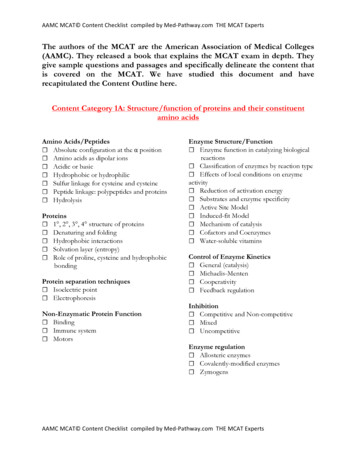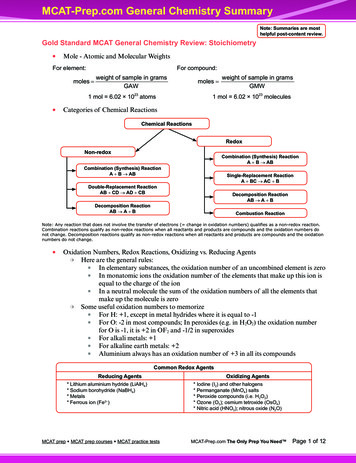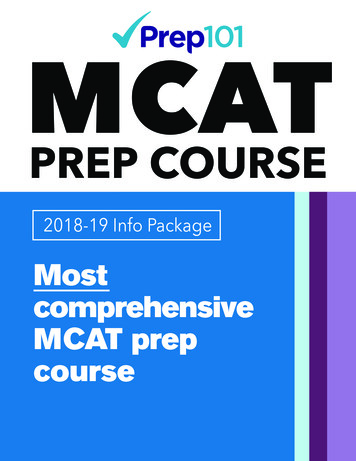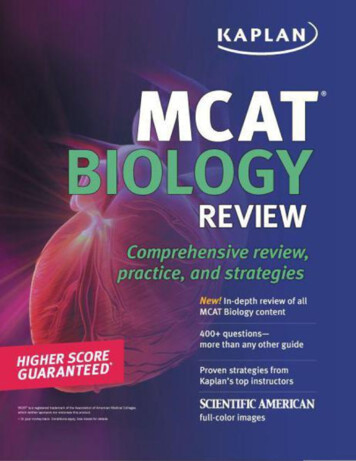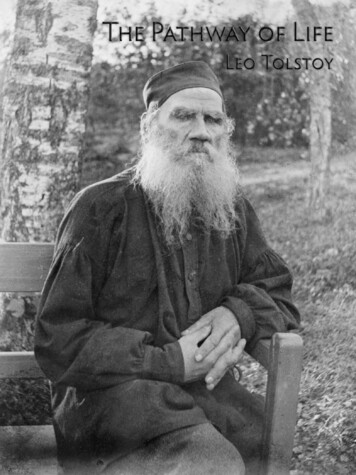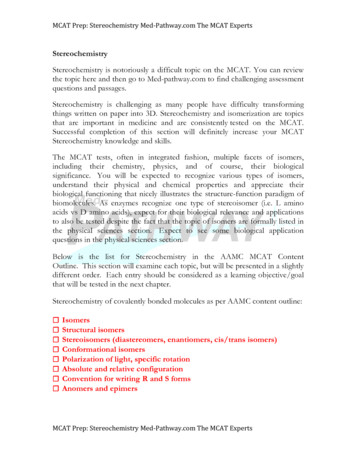
Transcription
MCAT Prep: Stereochemistry Med-Pathway.com The MCAT ExpertsStereochemistryStereochemistry is notoriously a difficult topic on the MCAT. You can reviewthe topic here and then go to Med-pathway.com to find challenging assessmentquestions and passages.Stereochemistry is challenging as many people have difficulty transformingthings written on paper into 3D. Stereochemistry and isomerization are topicsthat are important in medicine and are consistently tested on the MCAT.Successful completion of this section will definitely increase your MCATStereochemistry knowledge and skills.The MCAT tests, often in integrated fashion, multiple facets of isomers,including their chemistry, physics, and of course, their biologicalsignificance. You will be expected to recognize various types of isomers,understand their physical and chemical properties and appreciate theirbiological functioning that nicely illustrates the structure-function paradigm ofbiomolecules. As enzymes recognize one type of stereoisomer (i.e. L aminoacids vs D amino acids), expect for their biological relevance and applicationsto also be tested despite the fact that the topic of isomers are formally listed inthe physical sciences section. Expect to see some biological applicationquestions in the physical sciences section.Below is the list for Stereochemistry in the AAMC MCAT ContentOutline. This section will examine each topic, but will be presented in a slightlydifferent order. Each entry should be considered as a learning objective/goalthat will be tested in the next chapter.Stereochemistry of covalently bonded molecules as per AAMC content outline: IsomersStructural isomersStereoisomers (diastereomers, enantiomers, cis/trans isomers)Conformational isomersPolarization of light, specific rotationAbsolute and relative configurationConvention for writing R and S formsAnomers and epimersMCAT Prep: Stereochemistry Med-Pathway.com The MCAT Experts
MCAT Prep: Stereochemistry Med-Pathway.com The MCAT ExpertsIsomersIsomers are molecules that possess identical molecular formulas and masses,yet their three-dimensional structures vary due to differences in the spatialorientation of their constituent atoms. Various classes and properties ofisomers relevant to the MCAT will be examined here.Structural isomersAlso called constitutional isomers, structural isomers of molecules (such aspentane; see Table below) possess different bond connections, whilemaintaining identical molecular formulas (C5H12), and molecular masses (72.15g/mole). However, structural isomers have different physical and chemicalproperties. For example, the three structural isomers of pentane have differentboiling and melting points. Significantly, both n-pentane and isopentane(IUPAC name 2-methylbutane) are liquids at room temperature, butneopentane (IUPAC: 2, 2-dimethylpropane) is a gas at room temperature. Thedifference can be explained through the understanding that boiling point isdependent on intermolecular forces. The variations in physical propertiesbetween isopentane and neopentane clearly illustrate the distinct physicalproperties that exist between molecules with identical molecular formulas.Conformational isomersDue to free rotation around sigma (σ) bonds, molecules can exist in variousrotational states. Such conformational isomers have the exact bondconnections, yet differ in their rotational states. This is illustrated below with 1chloropropane. Panel A shows the perspective diagram focusing on theorientation of the groups on carbon atoms C1-C2. Note that the two largestgroups are orientated on opposite sides of the carbon backbone, but afterMCAT Prep: Stereochemistry Med-Pathway.com The MCAT Experts
MCAT Prep: Stereochemistry Med-Pathway.com The MCAT Expertsrotation around C1, the two groups are facing outwards. These two rotationaloutcomes are considered conformational isomers, or conformers.In many cases, conformational isomers are represented by Newman projectionsthat examine the molecule through a view of the longitudinal axis of the carbonskeleton. Newman projections examine the rotational states around carboncarbon σ bonds. Through examination of Panel B, we learn that theseprojections are drawn by starting with the initially viewed carbon as a point in avertex. This vertex is bound to four separate constituents, including the secondlongitudinal carbon that is represented by a sphere (Panel B). Stable carbonatoms are bonded to up to four constituent atoms. Remember that the valenceof carbon is 4 (electron configuration: 1s22p4). As shown, the anticonformation has the two largest groups bonded to C1 and C2 as they are lying180 apart. After rotating 60 , the two groups lie closer together in the gaucheconformation. Both the anti and gauche are considered as “staggered”forms. A further 60 rotation produces the eclipsed form. This is theconformation where both groups lie closest together. Such steric hindrancecreates electron repulsion, making the eclipsed form the least energeticallyfavorable of the conformational isomers (Panel C).MCAT Prep: Stereochemistry Med-Pathway.com The MCAT Experts
MCAT Prep: Stereochemistry Med-Pathway.com The MCAT ExpertsRing structures often exist in multiple conformations. In the example ofcyclohexane, the six-membered ring structure is often presented as a flat, planarstructure (The "top down" view). However, if this depiction were accurate, thebond angles would be 120 degrees. As the bonds in cyclohexane aresp3 hybridized, the most stable structure would have angles of 109.5degrees. Thus, being planar is not favorable for cyclohexane. To accommodateoptimal bond angles cyclohexane exists in the chair and boat conformationalisomers (conformers) as shown below. The chair form is the most stable.Geometric (cis/trans) isomersUnlike conformational isomers that arise through rotation around σ bonds,geometric isomers arise as a result of the consequence of the failure to rotatearound bonds. Geometric isomerization is listed on the MCAT checklist as“cis/trans isomers”. Cis refers to groups on the same side and trans indicatesgroups on opposite sides of carbon bonds.The common feature of geometric isomers is that they all possess structuresthat have some form of restricted rotation around a bond. As rotationalrestriction around double bonds is prohibited, geometric isomers are often seenin molecules with π bonds (sp2 carbon-carbon double bonds). Geometricisomerization is also found in ring structures. Note as shown below that the cisand trans-1, 2 dichlorocyclopentane geometric isomers are also diastereomers.This class of stereoisomers will be discussed below.MCAT Prep: Stereochemistry Med-Pathway.com The MCAT Experts
MCAT Prep: Stereochemistry Med-Pathway.com The MCAT ExpertsTwo geometric isomers exist for 2-butene: the cis and trans forms. The cisisomer is the form that has the two hydrogen atoms bonded to the sp2 carbonon the same side of the double bond; trans is when they lie on opposite sides.The boiling points (cis -139 C and trans -105 C) and melting points (cis 4.0 C and trans 1.0 C) for the two isomers are different.Geometric isomers for alkenes are formally designated with the E/Zsystem. Here are the rules for determining the Z and E. First, designatepriority assignments to each atom. To each of the two carbon atomsparticipating in the double bond, group priority numbers are assigned basedupon atomic number. As the atomic number of carbon is greater thanhydrogen (C H), the CH3 methyl group has a priority of 1 and the hydrogenhas a priority of 2. By definition, E isomers have each of the two number 1assignments on opposite sides of the double bond. If the two 1 assignmentsare on the same side, then the isomer is classified as “Z”. In most, but not all,cases, the E isomer represents trans.Stereoisomers (diastereomers, enantiomers, cis/trans isomers)Isomers that differ in their 3D-spatial arrangement of atoms are termedstereoisomers. Any molecule that cannot be superimposed on its mirror imageexhibits chirality. The simplest way to envision chirality is to note that your lefthand cannot be superimposed on your right hand: they are mirror images ofMCAT Prep: Stereochemistry Med-Pathway.com The MCAT Experts
MCAT Prep: Stereochemistry Med-Pathway.com The MCAT Expertseach other. Chirality refers to “handedness” and exists throughoutnature. Helices in nucleic acids and proteins have handedness. Thus, chirality isa term referring to handedness or symmetry, and is an intrinsic property ofstereoisomers.A molecule and its non-superimposable mirror image are calledenantiomers. The two enantiomers of the amino acid alanine are shown. Thered asterisk designates the chiral carbon stereocenter. The two molecules arenon-superimposable mirror images. Enantiomers possess identical physicalproperties (i.e. boiling and melting points) with the exception of how theyinteract with light (discussed below). A 1:1 mixture of enantiomers is called aracemic mixture. Any ratio of enantiomers deviating from 1:1 is called ascalemic omsorstereocenters. According to Mislow and Siegel, a stereocenter represents aposition in a molecule where the exchange of two groups generates astereoisomer. Stereocenters are often referred to as chiral or asymmetriccenters. Although many atoms can exhibit chirality, the MCAT will largely, ifnot exclusively, focus on carbon.MCAT Prep: Stereochemistry Med-Pathway.com The MCAT Experts
MCAT Prep: Stereochemistry Med-Pathway.com The MCAT ExpertsChiral molecules were first observed to interact with light and exhibit opticalactivity in the 1800s. Monochromatic light passing through a filter (Think oflight passing through a picket fence.) is polarized, or is able to pass through inone plane (See image above). When passing through a sample with opticalactivity (i.e. chiral molecule), the plane of polarized light rotates eitherclockwise (CW) or counter clockwise (CCW) at an angle α through itsinteraction with a chiral center. CW rotation is noted as ( ) or dextrorotatoryand CCW rotation is called (-) or levorotatory. Dextrorotatory and levorotatoryare often abbreviated with a small case d and l, respectively. Enantiomers willrotate the plane of polarized light in opposite directions, but with equalmagnitude. A racemic mixture will therefore fail to rotate the plane ofpolarized light as it has an equal mixture of and - rotating molecules. Thedirection and magnitude of rotation of a chiral molecule must beexperimentally measured by polarimetry. It cannot be determined by visualinspection of the molecule.The specific rotation [α] is the change in orientation of a chiral molecule whenexamined through a monochromatic source of polarized light as illustrated. αdepends on the concentration of the sample, the length of the sample cell,MCAT Prep: Stereochemistry Med-Pathway.com The MCAT Experts
MCAT Prep: Stereochemistry Med-Pathway.com The MCAT Expertstemperature, as well as the wavelength of the light source. The formula forspecificrotationisgivenby:[α] α/ (c)(l)[α] specific rotation, α observed rotation, c concentration of molecule(g/ml), and l path length of tube in decimeters.Identifying chiral centers and chiral moleculessp3 tetrahedral carbon atoms (109.5 bond angles) that have four differentsubstituent groups are identified as chiral centers. For example, one chiralcenter is found in alanine as shown above (Panel A). The chiral center isindicated with an asterisk. Observe that the chiral α carbon is tetrahedral andbound to four different substituents. Its mirror image is also shown.For a molecule with one chiral center, two enantiomers exist and possessidentical physical properties except for how they rotate the plane of polarizedlight. In general, there are 2N stereoisomers where N the number of chiralcenters. The two exceptions concern molecules with bridged structures (2N/2isomers) and the meso compounds (2N -1).Shown below is the meso compound, 1,2 dihydroxycyclohexane. The moleculehas two chiral carbons (asterisks) but exhibits no optical activity. This isbecause the meso compound has an internal plane of symmetry.MCAT Prep: Stereochemistry Med-Pathway.com The MCAT Experts
MCAT Prep: Stereochemistry Med-Pathway.com The MCAT ExpertsMolecules that have internal planes of symmetry are achiral. Meso compoundspossess at least two chiral centers yet have no optical activity due to the internalplane of symmetry. Meso compounds are therefore achiral. Therefore, thepresence of chiral centers does not automatically make a molecule chiral andthis is because of symmetry.Remember: Any molecule that has a plane of symmetry that can divide themolecule into two identical mirror images is achiral, even if there are chiralcarbon centers.Absolute configuration. As enantiomers possess differing spatial arrangementsof atoms, the R and S system for nomenclature has been adopted todifferentiate between them. This system is also applied to other stereoisomersincluding diastereomers and meso compounds. The R and S system is formallycalled Cahn-Ingold-Prelog system and the rules are described and implementedbelow for 2, bromo, 2 chloroethanoic acid, a molecule that has one chiralcenter and two enantiomers. The R and S isomers are shown below.MCAT Prep: Stereochemistry Med-Pathway.com The MCAT Experts
MCAT Prep: Stereochemistry Med-Pathway.com The MCAT ExpertsNote that for the S isomer, drawing an arrow from 1-3 generates a CCWdirection. For the R isomer, the drawn arrow from priorities 1-3, is also CCW.However, because the #4 priority H atom is NOT in the back (wedge vshedged line), the direction is changed to a CW arrow. This gives the assignmentas an “R”.Although not applicable in this specific case, the 4th rule for assigning absoluteconfiguration applies to chiral compounds with isotopes. When isotopes arebonded to a carbon stereocenter, the rules for assigning priorities state that thehighest mass number receives the highest priority. For example in the case ofhydrogen, Tritium (3H, mass number 3 from 1 proton and 2 neutrons) wouldhave a higher priority than deuterium (2H, mass number 2 from 1 proton and 1neutron), and hydrogen (1H) that has one proton and zero neutrons.In some cases, assigning an absolute configuration to molecules is not asstraight forward as determining priority numbers. Take the case of 2-chloroproprionic acid as shown below. The chiral carbon is shown with an asterisk.Although it is easy to assign the #1 and #4 priorities as Cl and H, respectively,the #2 and #3 priority assignments is less clear as both atoms appear to becarbon. As shown, in these situations, determine the “next” three bound atoms.In this case, this is the difference between a carbon and two hydrogen atoms(C, H, H) and a carbon and two oxygen atoms (C, O, O). Although the carbonsare equal in atomic number, since O H, the #2 priority is defined andassigned as shown.Relationship between R/S and, and –, and d/l system. We have seen thatchiral molecules rotate the plane of polarized light in either a clockwise ( ) orcounterclockwise (-) manner, which is linked to the d (dextrorotatory) and l(levorotatory) nomenclature. This is used to distinguish how a chiral moleculerotates the plane of polarized light. The ( )-d and (-)-l system describes how anentire molecule interacts with polarized light. In contrast, the R and S systemdefines the absolute configuration of individual chiral centers within amolecule. There is no relationship between the two systems of nomenclature,meaning that a chiral molecule with a single stereocenter assigned R does notindicate how this molecule will rotate the plane of polarized light ( or -).Further, when considering the d and l system, it is necessary to distinguish themeaning of the lower case nomenclature (direction of rotation in response topolarized light) to the upper case D and L nomenclature.Upper case D and L nomenclature refers to an alternative system fordesignating absolute configuration for amino acids and sugars. Therefore, DMCAT Prep: Stereochemistry Med-Pathway.com The MCAT Experts
MCAT Prep: Stereochemistry Med-Pathway.com The MCAT Expertsand L isomers can also be assigned through the R and S system by applicationof the Cahn-Ingold-Prelog rules. These points are illustrated in the figure withserine as the example. Historically, when glyceraldehyde is drawn in a Fischerprojection, if the OH group is drawn on the right then the molecule is the Disomer. If the OH is on the left, then this represents the L enantiomer. If thechiral carbons in D and L glyceraldehyde were assigned an absoluteconfiguration based upon the Cahn-Ingold-Prelog rules, then the D isomerrepresents the R configuration and the L enantiomer represents the Lconfiguration. However, you cannot always assume that D and Lconfigurations will equate to R and S assignments. The convention for aminoacids such as serine is slightly different (see image). If the α-NH3 group is onthe right in the Fischer projection, then the D configuration is assigned. Theconversion into the R and S system is shown through the priority assignments.Biological significanceIt is common for various enantiomers to be biologically active in one form, butnot another. This is naturally seen with the L-amino acids as they areMCAT Prep: Stereochemistry Med-Pathway.com The MCAT Experts
MCAT Prep: Stereochemistry Med-Pathway.com The MCAT Expertsincorporated into proteins, but the D isomer is not. This is further seen withcarbohydrates as they all exist in the D configuration in the human body. Thus,pharmaceutical drug design and synthesis is highly relevant for the study ofstereochemistry. Understanding stereochemistry is a prerequisite thedevelopment of pharmaceuticals.One example of the significance of stereochemistry concerns thetwo enantiomers of naproxen, an over the counter anti-inflammatorydrug. Immediately spot that the opposite orientation of the methyl groupsbonded to the sp3 chiral center. One molecule will be in the S configurationand the other will necessarily be in the R configuration as shown. Enantiomershave opposite configuration at EACH stereocenter. However, only the Sisomer acts as a therapeutically beneficial drug by inhibiting cyclooxygenasedependent synthesis of prostaglandins; the R isomer causes liver damage.Diastereomers and epimers possess at least two chiral carbon centers, yet aremolecules that differ in absolute chiral configuration in at least onestereocenter. Diastereomers are shown below in 2-chloro 3-bromopentanoicacid, a molecule with two chiral carbon centers. In this case there are 2N or 4different stereoisomers. Only one is shown. Enantiomers have oppositeconfiguration at each chiral center (i.e. R vs. S or RR vs SS). In contrast,diastereomers have opposite configurations in at least one stereocenter (i.e.RRR vs RRS). Those diastereomers that differ in absolute configuration aroundone chiral center are termed epimers. Therefore, all epimers are diastereomers,but not all diastereomers are epimers. Note the differences in absoluteconfiguration between enantiomers and diastereomers as shown in Panel D).MCAT Prep: Stereochemistry Med-Pathway.com The MCAT Experts
MCAT Prep: Stereochemistry Med-Pathway.com The MCAT ExpertsAnomersAnomers are a type of epimer. Their formation is illustrated with the classicsample of D-glucose as shown below in the image. Appreciate that glucosemolecules are in equilibrium between the linear form and their closed circularstructures. In the linear form, the hydroxyl group bound to carbon #5 (red inthe image) serves as a nucleophile. A lone pair of electrons in the oxygen atomattacks the sp2 carbon present in glucose. Because of the planar nature of thecarbonyl carbon, the nucleophile can attack from either of two positions (aboveor below the plane) as shown. This reaction introduces a new chiral center inthe closed glucose molecules.In the mechanism, the hydroxyl group performs a nucleophilic attack at carbon#1. As this electrophilic center lies in a planar structure due to thesp2 hybridization status of carbon (120 bond angles), the hydroxyl group canattack from either the top or the bottom to generate new molecules, oranomers. As a consequence, two isomers α (hydroxyl is down) and β (hydroxylis up) are formed. Note that the combined reaction of an alcohol (R-OH) withan aldehyde (CHO) generates a hemiacetal linkage. Because this newly formedhemiacetal bond is reversible (in contrast to an acetal), anomers caninterconvert in solution. The glucose molecule in solution exists in equilibriumbetween the open (1%) and closed forms (99 %). As per the figure, the βanomer is predominant (65 %) because, as seen in the chair structure, thehydroxyl at C1 is in the more stable equatorial position.MCAT Prep: Stereochemistry Med-Pathway.com The MCAT Experts
MCAT Prep: Stereochemistry Med-Pathway.com The MCAT ExpertsUpon further inspection of the structures of closed circular α-D and β-Dglucose molecules, it is clear that the newly formed bond at carbon #1 is in ahemiacetal linkage. Unlike acetal linkages, hemiacetal linkages are unstable.Thus, the circularization of glucose is freely reversible. As a consequence,glucose molecules are always opening and closing and opening back up again.At equilibrium, there is more α-D glucose present in solution.The nomenclature and mechanism of the formation of the α and β anomers ofD-glucose can also be discerned from the Figure. Note that Glucose exists inboth a linear and a circularized closed form (represented by the Haworth andchair structures). In the linear Fischer projection, if the hydroxyl group on thepenultimate carbon (red) is on the right, then this represents the D-isomer.(The L isomer has the hydroxyl group attached to the penultimate carbondepicted on the left side in a Fischer projection.The relationships between stereoisomers (i.e. structural and conformationalisomers is missing) is shown in the following Venn diagram.MCAT Prep: Stereochemistry Med-Pathway.com The MCAT Experts
MCAT Prep: Stereochemistry Med-Pathway.com The MCAT ExpertsMCAT Prep: Stereochemistry Med-Pathway.com The MCAT Experts
MCAT Prep: Stereochemistry Med-Pathway.com The MCAT Experts MCAT Prep: Stereochemistry Med-Pathway.com The MCAT Experts Two geometric isomers exist for 2-butene: the cis and trans forms. The cis isomer is the form that has the two hydrogen atoms bonded to the sp2 carbon on the






